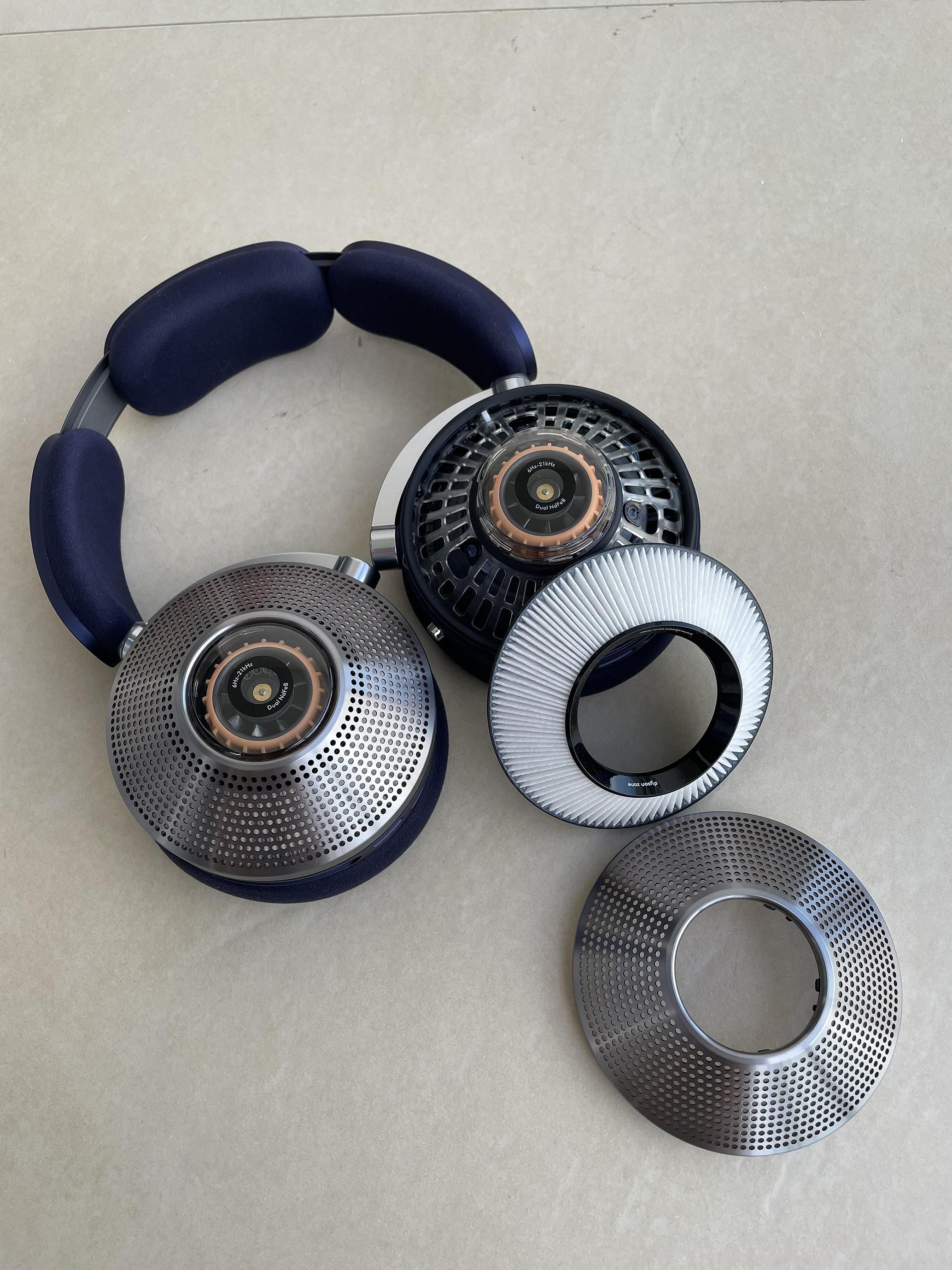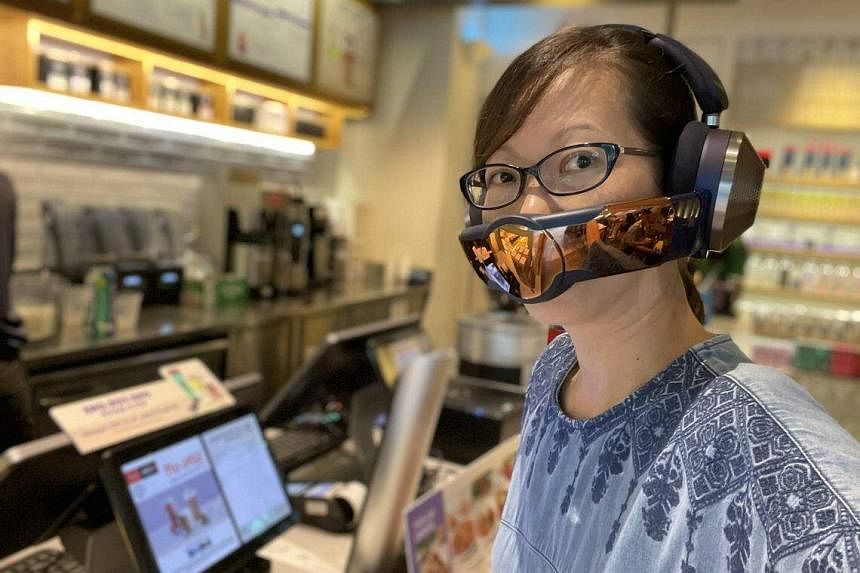SINGAPORE - I received more stares last week than I’ve had in my life. No wonder – I was walking around with a pair of helmet-like headphones and a metallic copper band across my mouth and nose, not dissimilar to Batman villain Bane’s mask.
I was trying out the latest device from home appliance maker Dyson, famous for its futuristic-looking, super-expensive stick vacuum cleaners. The Dyson Zone is a pair of air-purifying, noise-cancelling headphones. Yes, headphones that deliver purified, filtered air to the wearer as they walk around, chilling out in ultra-silence, listening to music or making phone calls.
It is Dyson’s first product for outdoor use.
At Ikea Jem in Jurong East, a promoter spotted my distinctive headgear and exclaimed: “It is one of the coolest things I’ve seen.”
At my daughter’s gymnasium, a parent asked: “Is this Dyson?” She recognised the Prussian blue and rich copper finishing synonymous with the brand. The Singapore-headquartered firm’s hairstyling products also come in these hues.
What I did not tell them was that, like Dyson’s stick-vac, it ain’t cheap – at $1,249 for the lower-end model in “ultra blue”.
It might be cold comfort, but this might be the best mobile air quality you can get. Say goodbye to stinky odours and choking pollution. The Zone’s pair of Hepa-like electrostatic carbon filters – Hepa stands for high-efficiency particulate air – is a type of pleated mechanical filter that can theoretically remove at least 99 per cent of dust, pollen, mould, bacteria and any airborne particles as tiny as 0.1 micron.
The inspiration for the Zone started six years ago, when Dyson looked at how to get around in polluted cities such as Beijing and Jakarta. Engineers realised a device that would do this required a bubble of clean air around the nose which moved as the head turns. To achieve this, the wearable purifier had to be mounted on headgear like headphones – less challenging than creating a new contraption from scratch.
This writer tested the $1,399 Zone, which goes on sale on Wednesday. Here is the verdict.
Hushing the bustle
I quickly became addicted to how quiet a city like Singapore can become, even in busy malls or on crowded trains. Dyson said the Zone’s microphones can reduce surrounding noise by up to 38 decibels. Tapping either ear cup twice enables users to switch between noise-cancelling and “transparency” modes, where noise-cancelling is put on hold. With each tap, there is a “whoosh” sound like what the Dyson vacs make when turned on or off.
In its noise-cancelling mode, music playback is crystal clear. However, I found the volume soft and often had to turn it up close to maximum. I was initially concerned that noise from the air-purifying motor on each earpiece would affect my music enjoyment, but it was barely audible.
The motors are mini versions of the company’s technology that powers its vacuum cleaners, bladeless fans and air purifiers. Air is pulled in through the earpiece, cleaned by electrostatic filters mounted on the ear cups and piped through the band covering your nose and mouth.

The band can be adjusted to sit comfortably without touching the face. It snaps on through magnets, allowing it to be flipped down and easily removed for conversations or for scanning facial ID to unlock phones.
With the device on, getting on and off an escalator required some practice, as the band blocked my view of my feet.
Four hours was the longest I could wear the Zone in air-conditioning. In Singapore’s blazing heat, I could barely manage 30 minutes without taking it off to clean the perspiration down the sides of my face or dry the sweat-soaked ear cups.
Still, the ear cups were soft, so there was no discomfort wearing them, although the device weighs almost 600g – hefty when compared with regular headphones weighing half of that. The plush cushioning under the headband also made prolonged wearing possible, barring the heat and humid conditions here.
Stench? What stench?

One thing that might make the average Singaporean stretch their budget for it is how useful it could be in the dreaded haze. Indeed, in April, when foggy skies threw up the possibility of haze, I thought it would be the perfect test for the Zone, given what it is designed to do. But the winds did not blow smoke from hot spots in the region to Singapore, making the product less compelling at the moment.
Still, at the maximum airflow setting, public toilets, fish markets and bus stops were more pleasant olfactory experiences. I could walk through a blanket of second-hand smoke at bus stops and mosquito fogging in my estate, catching only the slightest whiff of offensive smells. My exposure to harmful fumes also seemed significantly lower, as I experienced no coughing.
However, the Zone is not a sealed mask and Dyson makes no claims that it can completely eliminate exposure to micro particles and dangerous gases, including nitrogen dioxide and sulphur dioxide. Dyson also makes no claim that the Zone can replace surgical masks worn during the Covid-19 pandemic.
Some other brickbats
An auto mode that regulates airflow based on the user’s physical exertion does not regulate flow based on foul smells or pollutants, which is a shame.
An accompanying MyDyson app (for Android and iOS) shows live nitrogen dioxide data based on the air filtered. At bus stops, I could see these readings rise with each passing vehicle emitting exhaust fumes. But it is a pity the Zone does not have a particulate-matter (PM) sensor to report live PM2.5 and PM10 readings – smaller than 2.5 microns, including smoke, industrial emissions and fumes from burning candles; and smaller than 10 microns, including pollen.

However, the app shows current public information on outdoor air quality, temperature, and PM2.5, PM10 and nitrogen dioxide readings based on the user’s location.
For its price, I expect the Zone to better automate certain functions and inform its users of what is being filtered. Perhaps future models can embed more environmental sensors for this.
When running on the maximum airflow setting, the device’s battery life is short, at 1½ hours. At the lowest setting, it is up to four hours. Without using the air filters at all, the headset can provide up to 50 hours of audio.
‘Boiling the porridge’
One of the 11 microphones embedded in the Zone allows the headset to be used for telephony. I tried it on one of my favourite pastimes: “boiling telephone porridge”, which in Cantonese means chatting on the phone for a prolonged period until it heats up.
The Zone did not heat up as much as my iPhone during an hour-long phone call at an indoor lounge at my daughter’s gym. My headset also did a decent job producing crystal-clear sounds from the person I was talking to, even with the air purifier turned on.
However, there were several kinks. I experienced sound distortion during the phone call. It was corrected when I redialled. My WhatsApp call also dropped a couple of times due to headset connection issues. A Bluetooth connection reset corrected the problem.
The Zone did a wonderful job of cancelling the surrounding noise so I could hear the other party on the line clearly. But my friend could hear background noise competing with my voice.
I did not expect Dyson’s first foray into audio to be perfect. I also would not pick the bulky Zone over my Apple AirPods Pro for everyday use. Weekends may be exceptions.
Most people would baulk at the Zone’s absurd price. On the other hand, compared with similarly bulky virtual reality (VR) headsets such as those from Meta and PlayStation, the Zone is an easier sell for the mass market. At least, users won’t feel dizzy and they can wear the Zone for audio playback for a few hours.
Even so, the Zone will face similar challenges to the VR headsets. Price is one. Whether the product fits one’s lifestyle is another. The average Singaporean will probably not need a wearable purifier, as the city is not so polluted day to day. The real test for the local market comes when the regional haze hits.


